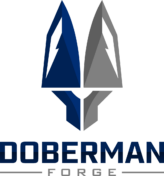
Like many in Stanly County, Gabriel Mabry has a shop in his garage. Unlike most of them, it’s not for his car.
Instead of rachets and wrenches, there are tongs and hammers. Instead of the smell of 5W-20, there’s the aroma of quenching oil. Instead of the roar of an engine, there’s the white hot blaze of a 2,400-degree forge.
“I’ve made a lot of this myself,” Mabry said, indicating the forge and tools scattered around his shop in Norwood.
A self-taught bladesmith, he learned most of what he knows from YouTube videos and online forums.
“But I think I’ve picked it up pretty well,” Mabry said.
Considering recent events, that may be a bit of an understatement.
Despite only three years as a bladesmith, Mabry was selected for History’s hit television series “Forged in Fire” this summer.
Each episode of the show pits four of the nation’s top bladesmiths against each other for three rounds of competition. During each round a competitor is eliminated until only one remains.
The episode Mabry will be featured in airs tonight at 9 p.m. A viewing party will begin at Little Tokyo on U.S. Highway 52 at 8 p.m.
“I was kind of surprised,” Mabry said of his selection for the show.
Many of the bladesmiths on the show have been plying their craft for decades, he noted.
“I haven’t been doing this long,” Mabry said.
The Albemarle native actually graduated from Johnson and Wales and worked as a professional chef for several years before going into IT more recently.
As for how he got into bladesmithing, that literally took a sign from God.
“It was actually reading the Bible that got me into bladesmithing,” Mabry explained.
Curious about a passage that talks about iron, he said, Mabry started researching blacksmithing and metallurgy for context information. The more he read, though, the more fascinated he got.
“I couldn’t stop. I binge researched for like months,” Mabry said. “Then one day I had the epiphany that I was going to try and build a forge myself.”
At first he used it to make simple products like railroad spikes and hooks. But after he got the hang of that, he decided to make a knife.
“As a chef, that’s something I’ve always appreciated, a good knife,” Mabry said.
While cooking at friends’ homes, he would often ask for their best chopper only to be handed some thin piece of steel, he said.
“I couldn’t tell which side was supposed to be sharp,” Mabry said. “I thought to myself, I can make something better than this.”
His first blade, though, wasn’t much less cringe-worthy.
Without any special tools, Mabry had to make the blade with hand tools alone. He did the edge with a file and the polish with sandpaper.
“It was ugly, just plain ugly,” Mabry summed up. “My dad still has it, but I’ve told him he’s not allowed to show anyone.”
But with more tools and more research, Mabry was soon crafting pieces that met even his high standards.
Over the next couple of years he replaced most of his friends’ knives with hand-forged blades and started his own business — Doberman Forge.
Today that forge produces custom knives for households and chefs throughout the country, including instructors at Mabry’s alma mater, Johnson and Wales.
“I think being a chef does give me some insights that might get lost in translation otherwise,” Mabry noted.
For example, one of the chefs at Johnson and Wales holds his knife in an unusual way when fluting mushrooms, Mabry noted. That works best with a wider blade, Mabry explained.
“But I don’t know how many bladesmiths would know to do that,” Mabry said.
Mabry’s style is also distinct for its minimalism.
Where other bladesmiths may be known for detail work or inlays, Mabry’s blades are known for their clean, simple lines and ergonomic function.
“I don’t want to just make something,” Mabry said. “I want it to have a purpose. Everything I do is functional.“
All of that proved enough for “Forged in Fire” to add him to its contact list for bladesmiths. The show is reaching out to that community in a variety of ways, Mabry noted. So several months ago, he received a flier from them as a kind of “casting call” for the show.
“It just seemed like a great opportunity, if I could get on there,” Gabriel said. “So I applied.”
After a questionnaire to test his knowledge of metallurgy, an interview and a background check, Mabry was selected to the show. Several weeks later, he was flown to New York for a weeklong filming process.
While the all-expenses-paid trip — including a visit to a historical weapons exhibit at the Metropolitan museum — was definitely a major highlight of the trip for Mabry, his favorite part a bit more unexpected.
“It was actually the guys I was competing with,” Mabry said. “I instantly made three new friends there, going through that experience with them. It was just a lot of fun… They are all so skillful. It was great to see what they did.”
As for the competition itself, Mabry is sealed to silence on that. But every episode has a special challenge for bladesmiths and this week’s episode will involve hacking some metal from a beat-up muscle car.
“I’m a little nervous,” Mabry admitted.
While the competition may be over, there are dozens of hours of competition and interviews on film, and he’s not sure what the producers will choose to use.
“But I love what I do and I’m glad I had the opportunity,” Mabry said. “I’m hoping this will give me the boost I need to do this full-time.”
To find out more about Mabry and his work visit www.dobermanforge.com. To find out more about “Forged in Fire,” visit www.history.com/shows/forged-in-fire.

